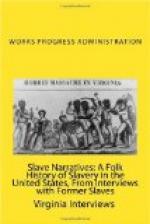“Sometimes the slaves would run away. Their masters wuz mean to them that caused them to run away. Sometimes they would live in caves. How did they get along? Well, chile, they got along all right—what with other people slippin’ things in to ’em. And, too, they’d steal hogs, chickens, and anything else they could git their hands on. Some white people would help, too, fur there wuz some white people who didn’t believe in slavery. Yes, they’d try to find them slaves that run away and if they wuz found they’d be beat or sold to somebody else. My grandmother run away frum her master. She stayed in the woods and she washed her clothes in the branches. She used sand fur soap. Yes, chile, I reckon they got ’long all right in the caves. They had babies in thar and raised ’em too.
“Ah stayed with the Mitchells ’til Miss Hannah died. Ah even helped to lay her out. Ah didn’t go to the graveyard though. Ah didn’t have a home after she died and Ah wandered from place to place, stayin’ with a white fambly this time and then a nigger fambly the next time. Ah moved to Jackson County and stayed with a Mister Frank Dowdy. Ah didn’t stay there long though. Then Ah moved to Winder, Georgia. They called it ’Jug Tavern’ in them days, ’cause jugs wuz made there. Ah married Green Hinton in Winder. Got along well after marryin’ him. He farmed fur a livin’ and made a good livin’ fur me and the eight chilluns, all born in Winder. The chilluns wuz grown nearly when he died and wuz able to help me with the smalles ones. Ah got along all right after his death and didn’t have sich a hard time raisin’ the chilluns. Then Ah married Jim Brown and moved to Atlanta. Jim farmed at first fur a livin’ and then he worked on the railroad—the Seaboard. He helped to grade the first railroad track for that line. He wuz a sand-dryer.”
Aunt Sally broke off her story here. “Lord, honey, Ah got sich a pain in mah stomach Ah don’t believe Ah can go on. It’s a gnawin’ kind of pain. Jest keeps me weak all over.” Naturally I suggested that we complete the story at another time. So I left, promisin’ to return in a few days. A block from the house I stopped in a store to order some groceries for Aunt Sally. The proprietress, a Jewish woman, spoke up when I gave the delivery address. She explained in broken English that she knew Aunt Sally.
“I tink you vas very kind to do dis for Aunt Sally. She neets it. I often gif her son food. He’s very old and feeble. He passed here yesterday and he look so wasted and hungry. His stomick look like it vas drawn in, you know. I gif him some fresh hocks. I know dey could not eat all of them in a day and I’m afrait it von’t be goof [TR: goot? or good?] for dem today. I vas trained to help people in neet. It’s pert of my religion. See, if ve sit on de stritcar and an olt person comes in and finds no seat, ve get up and gif him one. If ve see a person loaded vid bundles and he iss old and barely able to go, ve gif a hand. See, ve Jews—you colored—but ve know no difference. Anyvon neeting help, ve gif.”




